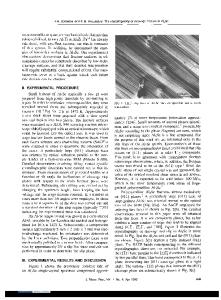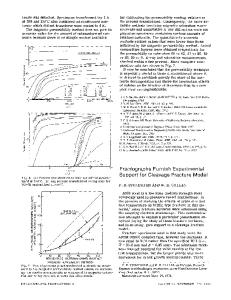Ideal Cleavage Fracture of Transition-Metal Silicides: A Comparison Analysis
- PDF / 430,430 Bytes
- 6 Pages / 417.42 x 644.58 pts Page_size
- 96 Downloads / 347 Views
TM aluminides and silicides were determined by carrying out ab initio calculations within the framework of the local density functional (LDF) theory, viz., in Ni3A1 [3], Ni 3Si [4], TiAI [5], Ti3A1 [6], and CoSi 2 [7]. In A13Sc [8], NiAl and FeAl [9], and MoSi 2 [10], uniaxial cohesive energies (or ideal work of adhesion) of a few low-index planes were determined as functions of the separation distance using the so-called supercell model. As compared to the slab model, supercell calculations of interfacial energies require relatively large amounts of computer times, particularly for TM silicides of complex crystal structures. In this paper, we first develop an empirical model for ideal work of adhesion based on the available results from the slab-supercell calculations. Second, ideal cleavage energies of TM silicides are estimated and critical stress intensity factors are determined. Third, validity and usefulness of the proposed method are discussed in light of the available experimental data. UNIAXIAL COHESIVE STRESS FUNCTION Consider a crystalline slab as illustrated in Fig. l(a) where the arrows indicate the direction of uniaxial tensile stress, ;, along the y-axis. The three length parameters of d0 , a, and D represent the interplanar spacing, the effective range of interatomic cohesive forces, and a scaling factor related to the maximum stress, ore, respectively. The change in total energy of a slab, AE, as it is separated into two halves, is to increase with increasing separation distance, v, as shown in Fig. 2(a). The corresponding tensile stress function is shown in Fig. 2(b) such that the ideal cleavage energy (without atomic relaxation or reconstruction after the rigid-body separation) is obtained by
G= f~a (v)dv =y+y 2
(.
KK6.6.1 Mat. Res. Soc. Symp. Proc. Vol. 552 0 1999 Materials Research Society
where y• and y2 are the specific energies per unit area of the two surfaces created when v _> a, as indicated in Fig. l(b). In ordered intermetallic compounds, these two surface energies are equal at some special crystallographic orientations only. In addition, for some (hkl) planes in noncubic crystal structures, there are more than one choice of atomically distinct cleavage plane.
zl Figure 1. Schematic illustrations of a supercell unit (a) and two parts (b) after separation.
D
d,
a
Y2
(b)
(a) 4
E
3
w 2
C
w
1
0 25 20 (L t1D
15
0 C6,
10
U)
5 0 0
0.1
0.2
0.3
0.4
0.5
Separation Distance, v (nm) Figure 2. Interfacial energy (a) and tensile stress (b) for the (100 plane in AI3Sc based on the ab initio supercell calculations [8]. KK6.6.2
The so-called universal binding energy relation (UBER) [11,12], which is known valid for metallic and covalently bonded solids, is used to fit the AE - v data of supercell calculations by AE(v) = -(Go/2) (1 + d*) ex[(-d*)
(2)
where d* is defined in terms of a scaling length, 1,as d* = v/l.. The uniaxial tensile stress function is given by G(V) = Gm
d* exp(1-d*)
(3)
where the peak tensile strength and the cleavage energy have the relationship o
Data Loading...











